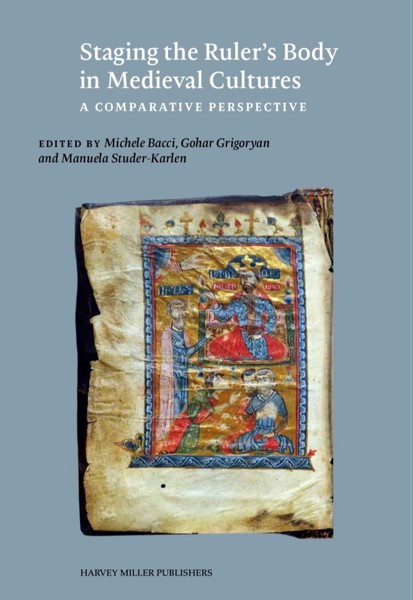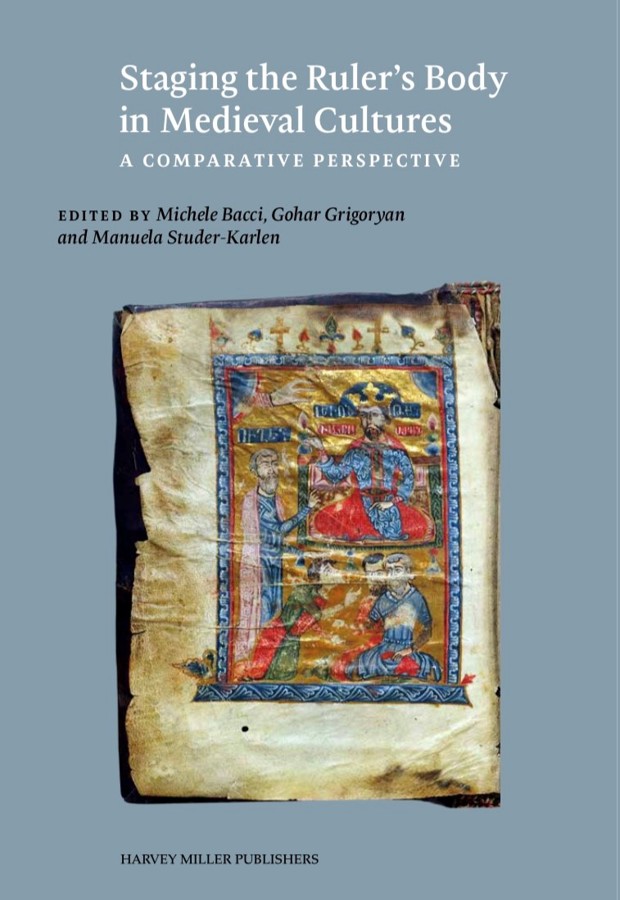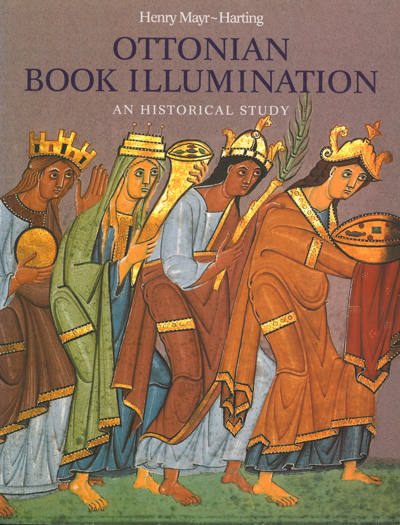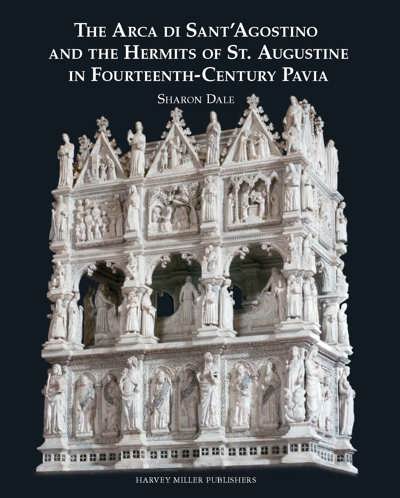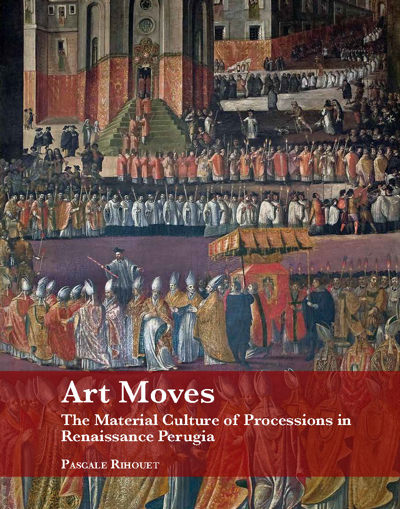
Staging the Ruler’s Body in Medieval Cultures
A Comparative Perspective
Michele Bacci, Gohar Grigoryan, Manuela Studer-Karlen (eds)
- Pages: 351 p.
- Size:180 x 265 mm
- Illustrations:1 b/w, 83 col., 1 tables b/w., 1 maps b/w
- Language(s):English
- Publication Year:2023
- € 75,00 EXCL. VAT RETAIL PRICE
- ISBN: 978-1-915487-08-7
- Hardback
- Temporarily Out of Stock
- ISBN: 978-1-915487-16-2
- E-book
- Available
The fifteen studies gathered in the book reflect on the mise-en-scène and representational devices of medieval rulers’ bodily appearances in Angevin, Aragonese, Armenian, Byzantine, Carolingian, English, Ethiopian, Georgian, Leonese, Sasanian and Sienese traditions.
"Deshalb bietet der Band ein erfreulich facettenreiches Panorama, dem auch ein extensiver Begriff des Mittelalters zugrunde liegt." (Michael Borgolte, in Francia, 2024/3)
"Transnational in scope and multifaceted in approach, this book has an impressive agenda and relies on a methodology that aims to overcome the traditional disciplinary boundaries between material studies, art history, and political theory. (...) This book should catch the attention of scholars in several disciplines interested in exploring further the bodily aspects of ruler ideology in the premodern world, who here have a rich source from which to feed." (Kim Bergqvist, in Ceræ, 11, 2024, p. 149-155)
"Overall, this volume successfully argues that the ruler’s physical body mattered, and does so with a variety of case studies and wonderfully color-illustrated figures. (...) The editors have assembled a stellar cast of contributors in order to discuss the place of the ruler’s body in the visual, sensorial, and emotional representations of rulership, which should be read with interest by specialists of political theology as well as those more generally interested in the Mediterranean and royal studies." (Edward L. Holt, in The Medieval Review, August 2025)
Michele Bacci is Professor of Medieval Art History at Fribourg University, Switzerland, and a member of the Academia Europaea. His research has been focused on artistic interactions in the Medieval Mediterranean and beyond, and the history of cult-objects and holy sites from a phenomenological-comparative viewpoint. He is the author of numerous publications, including Il pennello dell’Evangelista (1998), The Many Faces of Christ (2014), the Mystic Cave (2017), and Veneto-Byzantine Artistic Interactions (2021).
Gohar Grigoryan, Ph.D. (2017), University of Fribourg, is currently senior researcher at the same university within an SNSF-funded project. She is the author of over two dozen peer-reviewed articles on medieval Armenian art and history and of an upcoming monograph on royal imagery in Cilician Armenia.
Manuela Studer-Karlen, Ph.D. (2010), University of Fribourg, is a SNSF Professor for Medieval Art at the University in Bern. She has published a monograph on late antique sarcophagi and recently her habilitation has been published with the title: "Christus Anapeson. Image and Liturgy". Her research centres on the history of visual-cultural processes in late antiquity, the interactions among text, image and space in Byzantine churches, medieval Georgian art, and Gothic ivories.
This book explores the viewing and sensorial contexts in which the bodies of kings and queens were involved in the premodern societies of Europe, Asia, and Africa, relying on a methodology that aims to overcoming the traditional boundaries between material studies, art history, political theory, and Repräsentationsgeschichte. More specifically, it investigates the multiple ways in which the ruler’s physical appearance was apprehended and invested with visual, metaphorical, and emotional associations, as well as the dynamics whereby such mise-en-scène devices either were inspired by or worked as sources of inspiration for textual and pictorial representations of royalty. The outcome is a multifaced analysis of the multiple, imaginative, and terribly ambiguous ways in which, in past societies, the notion of a God-driven, eternal, and transpersonal royal power came to be associated with the material bodies of kings and queens, and of the impressive efforts made, in different cultures, to elude the conundrum of the latter’s weakness, transitoriness, and individual distinctiveness.
Michele Bacci, The Ruler’s Multiple Bodies and Their Mise-en-Scène: Some Introductory Remarks
Matthew P. Canepa, Staging the Body of the Lord of the Sevenfold World. Methectic Spaces and Chiasmatic Viewing in Sasanian Iran
Natia Natsvlishvili, Queen Consort Mariam Dadiani and Female Architectural Patronage in Late Medieval Georgia
Gohar Grigoryan, The ‘Just Judgement’ of King Lewon IV. Representational Strategies of Righteous Rulership in Cilician Armenia
Jacopo Gnisci, Royal Imagery and Devotional Spaces in Early Solomonic Ethiopia. The Case of Gännätä Maryam
Antony Eastmond, Staging as Metaphor. The King’s Body and the Theatricality of Power
Maria Parani, Clothes maketh the emperor? Embodying and Performing Imperial Ideology in Byzantium through Dress
Manuela Studer-Karlen, Staging for Commemoration: The Cherubikos Hymnos
Eleonora Tioli, The Khan in the West. The Reception of Mongol Political Power in the Texts and Images of Medieval Latin Europe
Kayoko Ichikawa, Staging the Virgin Mary as the Ruler of the Sienese City-State
Mirko Vagnoni, Shaping the Face of Power. The Portraits of King Robert of Anjou (1309-1343)
Aleksandra Rutkowska, Staging the Royal Corpse. Reburials of Monarchical Bodies at the Basilica of San Isidoro in León
Sofía Fernándex Pozzo, The Presence and Propaganda of Jaime the Conqueror of Aragon (r. 1213-76) in the Llibre dels Fets. The Image, Action, and Rhetoric of a King
Marta Serrano-Coll, The Royal Presence of Pedro IV (r. 1336-87) in Contemporary Textual and Iconographic Sources
Sabine Sommerer, Staging the Absent King. Effects of Presence on Medieval Royal Thrones
Index of persons
Index of places
